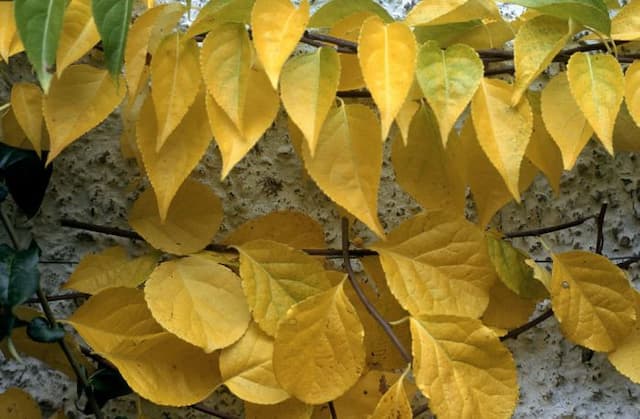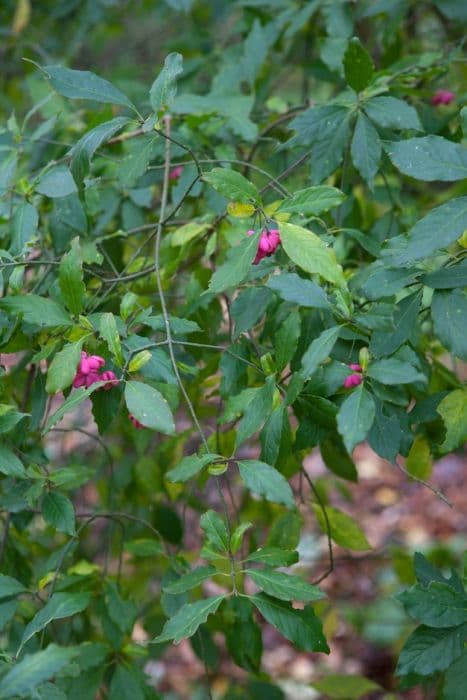Spindle 'Dart's Blanket' Euonymus fortunei 'Dart's Blanket'
ABOUT
A small, bushy evergreen shrub, ideal for ground cover to a height of 60cm, but will climb to 5m if planted against a wall. Leaves are dark green and rounded and turn bronze-red in winter; rarely flowers
About this plant
 Names
NamesFamily
Celastraceae.
Synonyms
Wintercreeper, Fortune's Spindle, Winter Creeper, Climbing Euonymus.
Common names
Euonymus fortunei 'Dart's Blanket'.
 Characteristics
CharacteristicsLife cycle
Perennials
Foliage type
Evergreen
Color of leaves
Green
Height
2 feet [0.61 meters]
Spread
6 feet [1.83 meters]
Plant type
Shrub
Hardiness zones
5
Native area
Asia
Benefits
 General Benefits
General Benefits- Low Maintenance: Euonymus fortunei 'Dart's Blanket', commonly known as Wintercreeper, requires minimal care once established.
- Drought Tolerance: It has the ability to withstand periods of low water availability.
- Ground Cover: Offers excellent ground cover, reducing soil erosion and suppressing weed growth.
- Year-Round Interest: Wintercreeper provides visual interest throughout the year with its evergreen foliage.
- Adaptability: It can adapt to a wide range of soil types, except extremely wet conditions.
- Attracts Wildlife: The dense foliage can provide shelter for small wildlife like birds and beneficial insects.
- Variegated Foliage: Adds aesthetic value to landscaping with its variegated leaves, which can brighten up shaded areas.
- Frost Resistance: The plant is resistant to frost, making it suitable for cool-climate gardening.
 Medical Properties
Medical PropertiesThis plant is not used for medical purposes.
 Air-purifying Qualities
Air-purifying QualitiesThis plant is not specifically known for air purifying qualities.
 Other Uses
Other Uses- Wintercreeper can be used to stabilize soil on slopes or in areas prone to erosion, thanks to its dense root system that can help hold the soil in place.
- The dense foliage of wintercreeper provides a protective habitat for small wildlife, including beneficial insects and nesting birds.
- Wintercreeper can be crafted into a living fence or privacy screen, providing a natural barrier that is both beautiful and functional.
- The trailing nature of wintercreeper makes it suitable for hanging baskets, where it can cascade over the edges for a lush, green display.
- When grown in containers, wintercreeper can be shaped into topiaries or formal garden designs to enhance aesthetic appeal.
- Because of its adaptability, wintercreeper can be used in xeriscaping plans, contributing greenery to landscapes that require minimal water.
- Wintercreeper can be trained over arbors or pergolas to create a green canopy, providing shade and a romantic garden setting.
- In regions with mild winters, wintercreeper can be used to add greenery to the garden during the colder months when many other plants are dormant.
- In coastal areas, wintercreeper serves as an effective windbreak when planted in thick hedges, safeguarding more delicate plants from harsh sea breezes.
- For those interested in crafts, the vines of wintercreeper can be woven into natural wreaths or other decorative items for rustic home decor.
Interesting Facts
 Feng Shui
Feng ShuiWintercreeper is not used in Feng Shui practice.
 Zodiac Sign Compitability
Zodiac Sign CompitabilityWintercreeper is not used in astrology practice.
 Plant Symbolism
Plant Symbolism- Endurance: Euonymus fortunei 'Dart's Blanket', also known as Wintercreeper, is often associated with endurance due to its hardy nature and ability to thrive in a variety of conditions.
- Adaptability: This plant symbolizes adaptability because of its tendency to easily climb and cover surfaces, reflecting its capability to adjust to its surroundings.
- Growth: Wintercreeper is often linked to the symbolic meaning of growth, as it is a fast-growing plant that can spread quickly when not managed.
- Fertility: Its vigorous spreading can also be interpreted as a symbol of fertility and the ability to propagate abundantly.
- Defense: The symbolism of defense comes from the plant's use in landscapes as ground covers that can prevent soil erosion and suppress weed growth.
 Water
WaterWintercreeper should be watered thoroughly, allowing the soil to become slightly dry between waterings. Typically, this means watering the plant every week or two, depending on the climate and weather conditions. Ensure you provide enough water to soak the root zone, which could be about 1-2 gallons for a mature plant, depending on its size and the soil type. During hot, dry periods, you may need to water more frequently, but always check the soil moisture before doing so. Overwatering can lead to root rot, so it is vital to ensure good drainage and to avoid letting the plant sit in waterlogged soil.
 Light
LightWintercreeper thrives in a variety of light conditions, from full sun to partial shade. Ideally, place it in a spot where it receives morning sunlight and partial shade in the afternoon, as this will encourage vibrant foliage color and dense growth. The plant can also adapt to full shade, but its growth may be less vigorous and its foliage less colorful.
 Temperature
TemperatureWintercreeper is hardy and can tolerate a range of temperatures, thriving ideally between 50°F and 80°F. It can survive minimum temperatures down to about -20°F, making it suitable for many temperate regions. Avoid exposing the plant to extreme heat above 90°F for prolonged periods, as this can stress the plant.
 Pruning
PruningPrune Wintercreeper to maintain a desired shape, control its spread, and remove any dead or damaged branches. The best time for pruning is late winter or early spring before new growth begins. Prune annually or as needed to keep the plant tidy, and use sharp pruning shears to make clean cuts.
 Cleaning
CleaningAs needed
 Soil
SoilWintercreeper thrives in well-draining, loamy soil with a pH range between 6.0 and 7.5. A mix of two parts garden soil, one part peat, and one part perlite or coarse sand is ideal for optimal growth and drainage.
 Repotting
RepottingWintercreeper should be repotted every 2-3 years to refresh the soil and accommodate root growth. It's best to repot in early spring before the growing season.
 Humidity & Misting
Humidity & MistingWintercreeper tolerates a wide range of humidity levels but prefers moderate humidity. No special humidity adjustments are necessary for this hardy plant.
 Suitable locations
Suitable locationsIndoor
Place in bright, indirect light with occasional watering.
Outdoor
Plant in well-draining soil; partial sun to full shade.
Hardiness zone
4-9 USDA
 Life cycle
Life cycleWintercreeper, Euonymus fortunei 'Dart's Blanket', begins its life cycle when seeds are disseminated by birds or other vectors after fruiting. These seeds undergo a period of dormancy until conditions are favorable for germination. Upon germinating in the spring, the seedlings establish themselves and begin to grow into dense, evergreen ground-cover mats. As the plant matures, it develops woody stems and can begin to exhibit climbing behaviour if vertical surfaces are available. Throughout its life, which can span many years, wintercreeper will continue to spread and can become quite invasive in some areas. The plant flowers in early summer, producing inconspicuous greenish flowers that, once pollinated, give way to the purple-red fruits that complete the life cycle when dispersed.
 Propogation
PropogationPropogation time
Spring-Early Summer
The most popular method of propagation for Wintercreeper, specifically the Euonymus fortunei 'Dart's Blanket', is through semi-hardwood cuttings. This is typically done in the latter part of summer. Cut a 4 to 6-inch (10 to 15 cm) length of semi-hardwood stem that has a few leaves at the top. Remove the leaves from the lower half of the cutting and dip this end into rooting hormone to enhance root development. Next, plant the cutting into a pot filled with moistened soil or a mix of peat and perlite, ensuring that the leafless part is buried. Then, cover the pot with a plastic bag or place it in a propagation chamber to maintain high humidity around the cutting. Keep the soil moist but not waterlogged and within a few weeks, the cutting should root and can eventually be transplanted outdoors.







